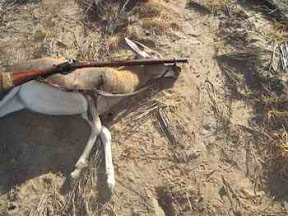In May 2004 I guided a group of American hunters on a wingshooting hunt on a concession near Reitz in the Free State. The land owner asked my if my clients would want to shoot two blesbok which had escaped from the camp in which they were kept to an area where they were not welcome. Naturally I agreed and let my clients have a go. Mr. Unnamed, with his .338 Norma Magnum, drew the short match and was first to try. Now to understand the situation you must know that the blesbok were on a very large open area of a few thousand acres, mostly fallow plowed fields. All the grass on water drainage strips and roads were mowed and removed. There was literally not a single tufft of grass for cover on the thousands of acres of rolling Free State farmland. My client got to about 450 yards and felt very confident that he could pull off the shot from there. Needless to say he underestimated the distance and cleanly missed by undershooting. A long and fruitless pursuit followed. End result: Still two blesbok alive at the end of the days hunt.
Then I decided that these two blesbok, a female and almost full-grown lamb, should fall to a muzzleloader!
Taking the opportunity of a gap between clients I traveled to Reitz and on Tuesday 15 June 2004 I visited the area dressed in a full gillysuit and armed with my muzzleloader. To stalk an animal you must first see it! Since just at daybreak I drove around the area in search. Then, eventually, at about 10.00 I first saw them! They were in the same area where my American client had a shot at them three weeks before. I drove away and parked the vehicle where they could not see it.
The stalk started. First I scanned and surveyed and planned. The actual hunt started with a walk for about 3/4 mile to the start of the most difficult and longest stalk in my 45 years of hunting. The only cover that I planned on using was a pump house about midway between the start and the blesbok. Topography was such that from the initial comfortable upright walking, it was straight to belly crawling for about 150 yards! Do you know how far 150 yards is when you crawl? Hell, it's agony! Then the land contour allowed me to get on hands and knees and crawl for about 100 yards. It sounds like fun, but if you are carrying a muzzleloader it actually means that you are on knees and one hand! There is a small spiny type of weed growing in those fallow fields that you never notice until you start using a knuckle to walk on!, and eventually crouch walked 300 yards to a pump house. Then had a long rest in reasonable comfort sitting behind a pump house.
Waiting to see if they were going to move and hoping, praying they would get closer than the guessed "much to far" where they seemed content to just stand and watch. Here I learned something about the ever-vigilant nature of the blesbok. Every few minutes the ewe would walk around a bit and face in a new direction! No hope of getting to within shooting distance while she 'looked the other way'!
The strategic possitioning of the blesbok was also clear. They were in a fallow field just on the highest point with a good view to all sides. It was a stalemate situation!Eventually, and very reluctantly, I decided that "Mohamed will have to go to the mountain!" I then had a mix of alternately belly crawling and crouch walking in the shallow water of a dam for about 200 yards.
Now here it was about mid-winter, and wearing normal leather hunting boots in the still a bit frozen shallow water resulted in wet and cold feet! Eventually a short hands and knees crawl brought me to a shooting spot on the dam wall. Now the lamb was closest, the ewe when last seen was still to far to risk a shot. I decided that if the lamb followed it's mother the opportunity to get one would be lost and so the lamb would be shot at first!
At just about 15.00 the stalk ended with a prayer and a slow trigger squeeze. At the shot the young buck lurched, stumbled a few paces and went down.
Actual shooting distance was paced off as 97 long paces. She was hit high through both lungs, a complete body penetrating shot.
 |
| From Andrew McLare... |
Shooting was with my Westley Richards Monkeytail using a 405 grains slug fired by 100 grains black power and used only as a muzzleloader. The rifle is of military configuration and was manufactured in 1873; at least this date is stamped on the lock plate. The rifle was completely shot out when I got it, but cutting about an inch off the barrel, crowning and refurbishing it a bit resulted in quite a good shooter.
Don't quite know which day I enjoyed most, last week Tuesday, with it's five hours' stalk, or the first day of my honeymoon? The beauty of the situation is that there is really no such thing as a "second honeymoon", and next month it is the time for the mother! Man, do I look forward to that one!
Postscript: It turned out that a poacher got the mother before I had a chance.





